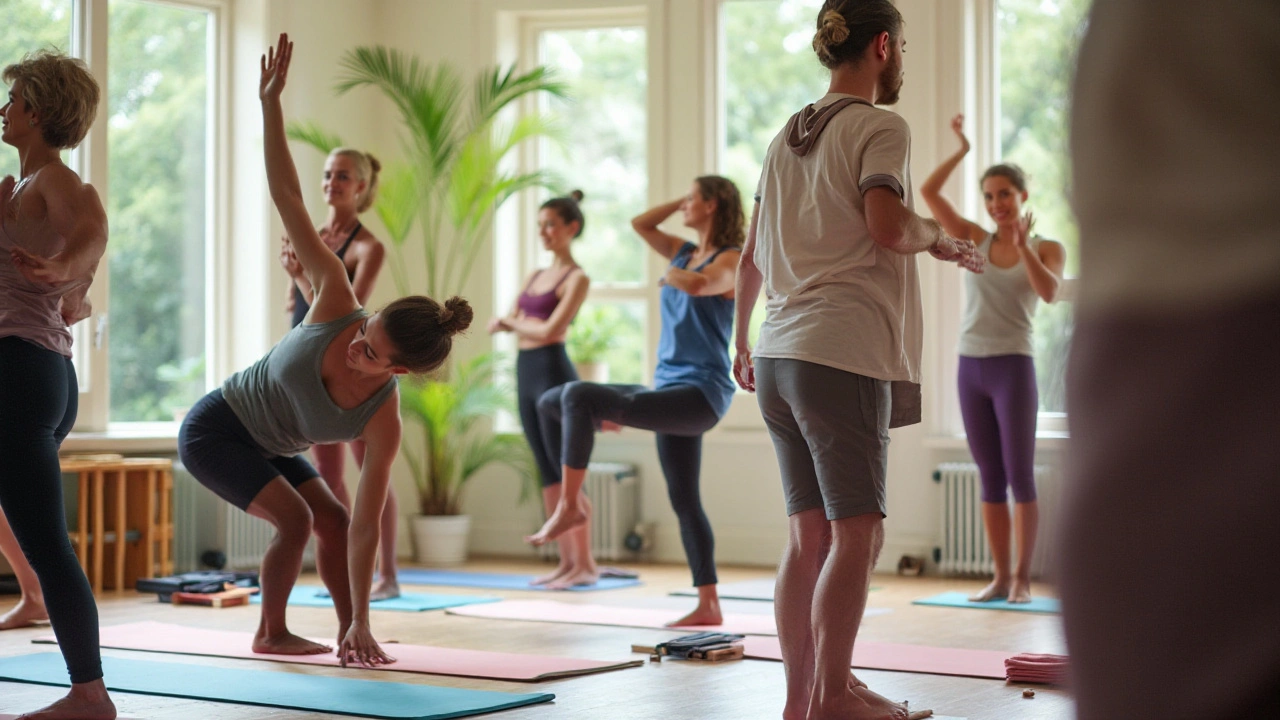Discovering the Secrets of Fascia Stretching and Its Benefits
 Oct, 27 2024
Oct, 27 2024
Fascia stretching is a practice that’s been floating around the fitness world more and more, capturing the interest of athletes and wellness enthusiasts alike. But what exactly is it, and why should anyone pay attention? At its core, fascia is the sheath of connective tissue that wraps around organs, muscles, and even nerves, binding them together in a web-like fashion.
Despite its newfound popularity, fascia has been part of our body system all along, silently doing its job without much recognition. Understanding it better can open doors to enhanced physical performance and an overall better understanding of how our bodies function. It’s not just about moving muscles; it’s about enhancing that hidden layer that holds everything together.
- Understanding Fascia
- Benefits of Fascia Stretching
- Techniques for Effective Stretching
- Incorporating Fascia Work into Daily Life
Understanding Fascia
Fascia is often described as the body’s secret organ system, a web of tissue that intricately weaves through every part of our anatomy. Despite its low profile in medical discussions for many years, fascia is now stepping into the spotlight. This connective tissue surrounds and supports muscles, bones, and internal organs. Imagine it as a cling film wrapping around individual components of a machine, ensuring everything stays in place yet functions with fluidity.
Not only does fascia provide support, but it also has a role in protecting and communicating across different regions of the body. Its sensitivity and ability to react to bodily changes are remarkable. Scientists have discovered that it’s packed with nerve endings, suggesting that it plays a crucial role in pain and proprioception—that is, the body’s ability to sense its position in space. Interestingly, fascia responds to stress and tension by changing its properties, which can result in restrictions or even pain if not addressed properly.
A growing body of research indicates that tight fascia can contribute to a range of issues, from reduced flexibility to chronic pain conditions. Dr. Thomas Myers, a pioneer in the study of anatomy trains, explains this beautifully, "
The fascial system is the missing element in the movement/stability equation."This intricate fabric does more than simply provide structure; it affects how muscles work and how efficiently they operate. It's closely linked to movement efficiency and injury prevention, making its care and stretching crucial to physical health.
Understanding fascia's interconnected nature gives insight into why attention to this tissue has become popular in the world of flexibility and wellness exercises. Fascial tension can be likened to wearing a restrictive outfit. When too tight, it limits movement, impacting how comfortably and freely we can move. Stretching the fascia helps to diminish these restrictions, enabling better movement and reduction of tension.
Another fascinating aspect is the fascia's adaptability. It remodels in response to physical demands, leading to the saying among bodywork professionals: "As the fascia goes, so goes the body." This adaptability also means that with consistent practice of fascia stretching, significant improvements in mobility and reduction in physical discomfort can occur. Spread across various layers, fascia does more than meets the eye, proving itself essential for maintaining structural integrity and balance within the body.
A detailed study table that highlights the significant differences in flexibility levels amongst athletes before and after a 6-week fascia specific stretching program can be illustrative:
| Athlete Category | Flexibility Improvement (%) |
|---|---|
| Recreational | 15% |
| Semi-professional | 20% |
| Professional | 25% |
Comprehending this hidden but impactful tissue opens new doors to improving how we move and feel. Understanding its unique characteristics leads to more informed approaches in promoting wellness and enhancing body movement.

Benefits of Fascia Stretching
When diving into the world of fascia stretching, it's easy to see how this practice goes beyond simple body movement. Unlike typical stretching, fascia stretching targets the entire connective framework of the body, which often leads to an array of unexpected benefits. One major advantage is increased flexibility. People who regularly engage in fascia stretching often notice a much wider range of motion, which is crucial not just for athletes but for anyone wanting to move with ease. This happens because fascia stretching loosens the connective tissue, allowing muscles to stretch without restrictions.
In addition to flexibility, another significant benefit of fascia stretching is pain reduction. Often, individuals who suffer from chronic pain find a surprising relief after incorporating fascia stretches into their routines. This is because tight fascia can create tension and pressure on nerves and muscles, leading to discomfort. By stretching this tissue, it's possible to alleviate some of that tension, resulting in a more relaxed and painless experience in daily activities. For those who spend long hours sitting at a desk or partaking in repetitive movements, this can make a world of difference.
Not only does fascia stretching provide relief and mobility, but it also enhances blood circulation. Good circulation is key to supplying muscles and organs with necessary nutrients and oxygen, promoting faster recovery from injuries or strenuous workouts. By loosening the fascia, blood can flow more freely through the tissues, ensuring that every part of the body receives what it needs to function optimally. This can lead to better performance, not only on the field or at the gym but also in being more energetic and focused in day-to-day tasks.
Another impressive area where fascia stretching makes an impact is stress reduction. When the fascia is tight and knotted, it can contribute to feelings of stress and anxiety as the body's physical state can deeply influence mental well-being. Engaging in regular fascia stretching exercises encourages the release of endorphins, which are natural feel-good hormones, and helps calm the nervous system. This not only brings about a sense of calmness and relaxation but also improves sleep quality.
"Fascia is your body's version of the environment," says Tom Myers, author of Anatomy Trains. "When it's restricted, circulation is impaired, tissues struggle to communicate, and this can lead to dysfunction."
These benefits present fascia stretching as a valuable tool for improving one's quality of life. Whether you're looking to enhance sports performance, reduce discomfort, recover quicker, or simply find a bit of peace in a hectic world, understanding and utilizing fascia stretching might just be the answer. With a routine involving simple stretches consistently, reaching higher levels of wellness becomes attainable.

Techniques for Effective Stretching
Embracing the art of fascia stretching can completely transform how we experience movement and reduce tension. This technique demands a slightly different approach compared to traditional stretching. The journey begins with slow, intentional movements focusing on breath and awareness. One recommended practice is to begin by warming up the body. Gentle movements increase blood flow, making the fascia more pliable.
The magic of fascia stretching lies in the duration and type of stretch. Holding a pose or stretch for an extended period - generally around three to five minutes - allows the fascia to lengthen and release tension effectively. Unlike muscle stretching, which seeks momentary lengthening, fascia stretching is about sustained tension and is not about bouncing or forcing your body into positions. Instead, it's about reaching your limits gently and patiently waiting for that subtle 'release' feeling.
"Movement is the song of the body and fascia is the instrument through which it plays." - Gil Hedley, PhD., an expert in human dissection and movement.
Breathing Techniques
Breathing is pivotal during these stretches. Deep-breathing techniques help in relaxing the body further, allowing the fascia to unwind fully. Inhale deeply, and with every slow exhalation, imagine releasing the tightness around the area being stretched. This visualization, paired with the breath, can be very effective. Focused breathing signals your nervous system to calm down, which in return, unwinds the fascia and muscles more effectively.
Targeted Stretches
Some effective stretches involve targeting specific body parts like the spine, hips, and shoulders where the density of fascia is usually greater. The 'caterpillar stretch' is excellent for the spine and can be done by sitting with extended legs and folding forward, keeping the back straight and head bowed towards the knees. For hips, a deep lunge with gentle pulses helps in opening up the pelvic fascia. Shoulder stretches with palms pressed together above the head elongated in gentle upward pulls can create significant releases in tension.
Consistency is key, and incorporating these into your routine three times a week can result in impressive flexibility gains and reduction in body stress. Consider combining these stretches with tools like foam rollers and massage balls for additional pressure, which might expedite release, especially in areas that feel denser or more tense.

Incorporating Fascia Work into Daily Life
Bringing fascia stretching into your everyday routine doesn't have to be a chore, and it certainly doesn’t require a gym membership. This practice is something you can do at home, at work, or even while traveling. Its flexibility in terms of fitting into your life is one of its greatest strengths. The idea is to find pockets of time throughout the day where you can incorporate movements that help release and stretch your fascia. Start with simple morning stretches as you get out of bed, which isn't just a good way to shake off the remnants of sleep but also primes your connective tissue for the day ahead.
Consider integrating mindful movements into everyday tasks. When you're standing by the kitchen counter waiting for your coffee to brew, for instance, take the opportunity to do some gentle backbends or side stretches. By doing this, you aren't just marking time—you’re investing it wisely in yourself. Discover stretches that target common problem areas like the shoulders, lower back, and hips, which can often feel tight after long periods of sitting. Use these moments to increase your body awareness, which can be incredibly rewarding in the long run.
Despite the general busyness of modern life, there's always room for a quick stretch. Even during your workday, a few minutes of fascia-focused stretching can improve your mobility and focus afternoon. According to the National Institute for Occupational Safety and Health, engaging in quick, regular stretching breaks improves productivity and reduces stress-related injuries. While you embark on this journey, consider using tools like foam rollers or massage balls. These can help target deeper layers of fascia, offering relief and enhanced flexibility with just a little bit of effort.
At night, unwinding with some more intentional stretches acts as a calming ritual that assists you in decompressing after a long day. Try setting aside time to practice yoga or tai chi, both of which are excellent ways to engage the fascia in low-impact, meditative conditions. You may even find solace in creating a peaceful corner in your home dedicated to such routines, with calming music or guided videos to support your efforts. This doesn't just contribute to your physical health but also nurtures your mental well-being.
The beauty of fascia stretching is in its adaptability and personalization. Whether you're a seasoned athlete or someone just starting their fitness journey, integrating these practices at home is not only feasible but advantageous. By experimenting with different movements and tools, you’ll gradually discover what works best for your body, encouraging a lasting commitment to your health. As quoted by Gin Miller, a noted fitness expert, "Exercise with purpose. Make each move an investment in your health, discovering what your body can do for you." This mindset is pivotal to successfully incorporating fascia stretching into daily life, turning each movement into an enlightening experience.
